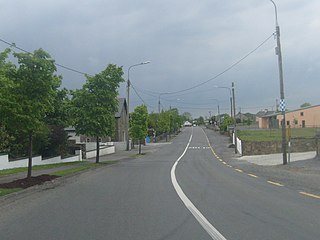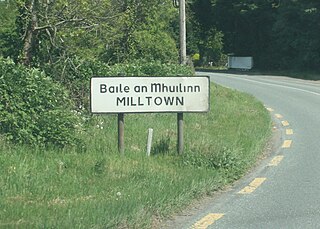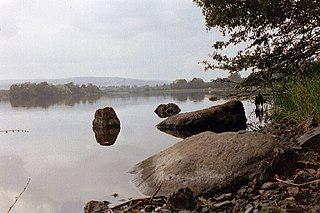
Killeshandra or Killashandra, is a village in County Cavan, Ireland. It is 20 kilometres (12 mi) west of Cavan Town in the centre of County Cavan's lakeland and geopark region and the Erne catchment environment of rivers, lakes, wetlands and woodland. Together with the Lough Oughter Special Protected Area (SPA), it has been recognised by the EU programme for wildlife Natura 2000 since 2010. Killeshandra is noted by Fáilte Ireland as an "Angling Centre of Excellence", and as a hub for the Cavan Walking Festival which takes place in May each year. There are several looped walking and cycling trails in Killykeen Forest Park. The town is also home to Killeshandra Gaelic Football Club, known locally as the Killeshandra Leaguers. Rockfield Lake, which is popular with anglers, is a few kilometres southwest of the town.

Milltown is a small village in County Galway, Ireland. It is situated on the banks of the River Clare, 47 km from Galway City, 11 km from Tuam on the N17 road to Sligo.

Milltown is a village in County Kildare, Ireland. The village is in the townland of the same name in the civil parish of Feighcullen It is 7km from the town of Newbridge. It is on the R415 regional road between Allenwood and Crookstown.
Aghavoher is small a townland in the civil parish of Tomregan, County Cavan, Ireland. It is approximately 0.9 square kilometres (0.35 sq mi) in area and lies in the former barony of Loughtee Lower.

Cranaghan is a townland in the Parish of Tomregan, Barony of Loughtee Lower, County Cavan, Ireland.

Drumlane is a townland situated near the village of Milltown, area 85.76 hectares, in County Cavan, Ireland. Drumlane is also the name of the civil parish in which the townland is situated. Saint Columba brought Christianity to Drumlane in 555, and Saint Máedóc of Ferns was the patron saint of Drumlane Abbey. Saint Máedóc made the Connachta nobleman Faircheallaigh the first Abbot of Drumlane in the 7th century and his Ó Faircheallaigh descendants were historically the Abbots of Drumlane. The name Drumlane denotes the drumlin region of low hilly ribbed moraines formed over a limestone bedrock created by the movement of glacial ice and melt water during the last ice age. Several townlands in the neighbourhood are prefixed with the word 'Drum', while several others are prefixed with the word 'Derry', which is Irish for oak.
Ray is a townland in the civil parish of Templeport, County Cavan, Ireland. It lies in the Roman Catholic parish of Templeport and barony of Tullyhaw.
Killywillin is a townland in the civil parish of Templeport, County Cavan, Ireland. It lies in the Roman Catholic parish of Templeport and barony of Tullyhaw.
Moherloob is a small townland in the civil parish of Templeport, County Cavan, Ireland. It is 0.45 square kilometres (0.17 sq mi) in area and lies in the barony of Tullyhaw. As of the 2011 census, there were no people living in Moherloob.

Erraran (from Irish: Airearan, meaning 'Land bordering a Lake' is a townland in the civil parish of Templeport, County Cavan, Ireland. It lies in the Roman Catholic parish of Templeport and barony of Tullyhaw.
Mullaghlea is a townland in the civil parish of Templeport, County Cavan, Ireland. It lies in the Roman Catholic parish of Templeport and barony of Tullyhaw.

Arderry is a townland in the civil parish of Templeport, County Cavan, Ireland. It lies in the Roman Catholic parish of Corlough and barony of Tullyhaw.

Tirnawannagh is a townland in the civil parish of Templeport, County Cavan, Ireland. It lies in the Roman Catholic parish of Corlough and barony of Tullyhaw.
Moneynure is a townland in the civil parish of Templeport, County Cavan, Ireland. It lies in the Roman Catholic parish of Corlough and barony of Tullyhaw.
Drummully East is a townland in the civil parish of Kildallan, barony of Tullyhunco, County Cavan, Ireland.

Greaghrahan is a townland in the civil parish of Drumlane, Barony of Loughtee Lower, County Cavan, Ireland.

Tomkinroad is a townland in the civil parish of Drumlane, Barony of Loughtee Lower, County Cavan, Ireland.

Ardue is a townland in the civil parish of Drumlane, Barony of Loughtee Lower, County Cavan, Ireland.

Killywilly is a townland in the civil parish of Drumlane, Barony of Loughtee Lower, County Cavan, Ireland.
Rockfield Lake, also known as Rockfield Lough, is a lake or lough situated between Carrigallen and Killeshandra, two small towns on the northern edge of the Midlands in Ireland. Part of the lake is in County Leitrim, which is part of the Province of Connacht, while most of the lake is in County Cavan, which is part of the Province of Ulster. This means that the provincial boundary between Connacht and Ulster runs through the lough. The Cullies River flows through Rockfield Lake, entering the lake at its southern end and flowing out of the lake at its north-western end. This small river flows from nearby Cullies Lake, and flows on, via Drumhart Lake, through Rockfield Lake to Glasshouse Lake.















